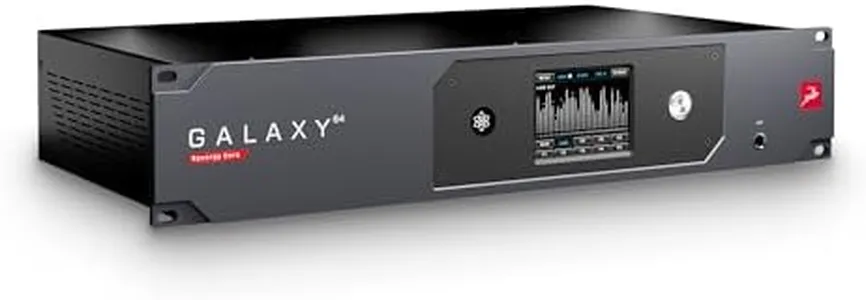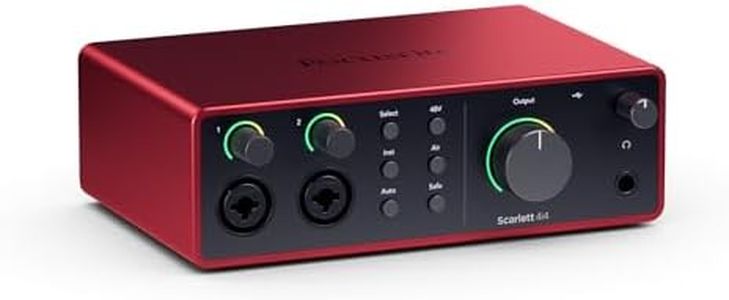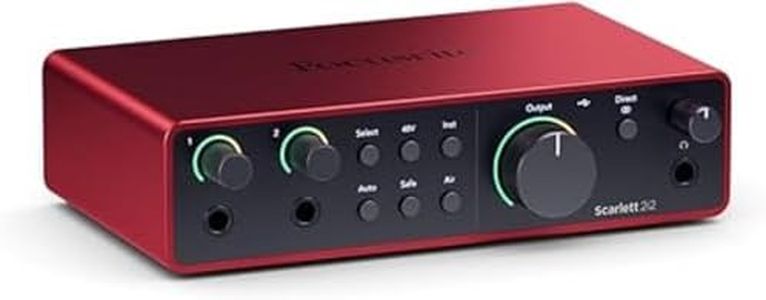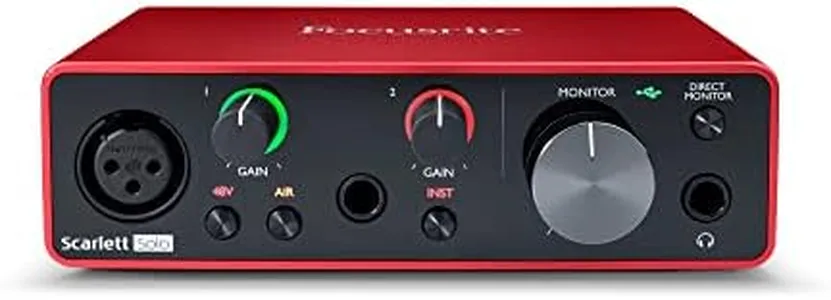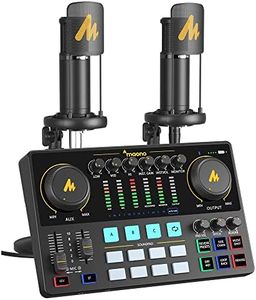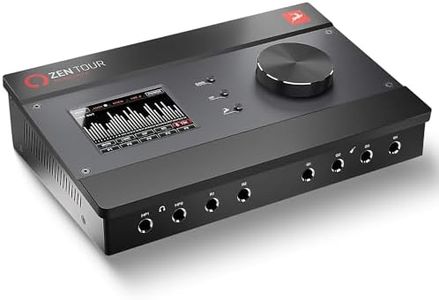10 Best Audio Interface 2025 in the United States
Our technology thoroughly searches through the online shopping world, reviewing hundreds of sites. We then process and analyze this information, updating in real-time to bring you the latest top-rated products. This way, you always get the best and most current options available.

Our Top Picks
Winner
Focusrite Scarlett 4i4 4th Gen USB Audio Interface, for Musicians, Songwriters, Guitarists, Content Creators — High-Fidelity, Studio Quality Recording, and All the Software You Need to Record
Most important from
33094 reviews
The Focusrite Scarlett 4i4 4th Gen is a solid choice for musicians, songwriters, guitarists, and content creators who want a reliable and versatile audio interface for studio-quality recording. It offers a good balance of inputs and outputs with 2 mic preamps, 2 high-impedance instrument inputs, plus 4 line inputs and outputs, making it flexible for connecting mics, guitars, synths, and drum machines. Using a USB-C connection, it provides seamless compatibility with both Mac and Windows systems. The interface delivers excellent sound quality thanks to high-end converters and a wide dynamic range (120dB), which helps capture clear and detailed recordings. Its preamps include Focusrite’s signature “Air” mode, enhancing vocals and guitars with a pleasant brightness.
Features like Auto Gain and Clip Safe help simplify recording by automatically setting levels and preventing distortion. The unit also supports phantom power for condenser mics, a must-have for many recording setups. In terms of build, the aluminum body feels sturdy yet compact and portable enough for home or mobile studios. Latency is low, ensuring real-time monitoring without annoying delays. Although the 4i4 is not the most extensive option in terms of channels, it suits solo artists or small bands who need multiple inputs without going overboard. For those seeking straightforward setup, professional sound, and solid build quality without complexity, this interface meets those needs well.
Most important from
33094 reviews
Focusrite Scarlett 2i2 4th Gen USB Audio Interface for Recording, Songwriting, Streaming and Podcasting — High-Fidelity, Studio Quality Recording, and All the Software You Need to Record
Most important from
33094 reviews
The Focusrite Scarlett 2i2 4th Gen USB Audio Interface stands out in the audio interface category, particularly for those looking to record music, stream, or podcast. With two inputs and high-quality preamps, it allows you to connect both a microphone and an instrument simultaneously, making it versatile for musicians and content creators alike. The studio-quality sound it delivers is impressive, thanks to a dynamic range of 120dB and the inclusion of advanced features like Auto Gain and Clip Safe, which help ensure that your recordings are clean and professional without the worry of distortion.
One of the key advantages of the Scarlett 2i2 is its build quality; it's made from durable aluminum, which adds to its portability. Weighing just 1.73 pounds and compact in size, it’s easy to transport for on-the-go recording sessions. Additionally, it comes bundled with a comprehensive software package, including plugins that cater to beginners and experienced users, making it a great entry point for those new to recording.
There are some considerations to keep in mind. While it has solid performance, it only offers two channels, which may not be sufficient for users who need to record multiple instruments or vocals at once. Also, while the USB-C connection is modern and efficient, it requires a compatible cable, which may not be included in every setup. Lastly, although the latency is relatively low, some users might still experience slight delays, particularly in more complex recording situations.
Most important from
33094 reviews
Focusrite Scarlett Solo 4th Gen USB Audio Interface, for the Guitarist, Vocalist, or Producer — High-Fidelity, Studio Quality Recording, and All the Software You Need to Record
Most important from
33094 reviews
The Focusrite Scarlett Solo 4th Gen USB Audio Interface is well-suited for musicians, vocalists, and producers seeking high-quality recordings in a compact form. With its two channels, this interface allows you to connect both a microphone and an instrument simultaneously, making it ideal for live performances and studio recordings alike. The USB-C connectivity ensures fast and reliable connections to various devices, including computers and tablets. One of its standout features is the impressive 120dB dynamic range, which brings studio-level sound quality to any recording setting. The improved Air mode also enhances the presence of both vocals and guitars, giving your recordings a more professional sound. Additionally, the included software package offers everything from recording to mixing, which is a big plus for beginners and experienced users alike.
The Scarlett Solo is portable and lightweight, making it easy to transport. While it has one XLR input and one instrument input, it may be more suitable for solo artists or small home studio setups. Latency is generally low, which is advantageous when recording.
The Focusrite Scarlett Solo 4th Gen is a fantastic choice for solo artists or small home studio setups, delivering excellent audio quality and user-friendly features, though its limited input options may not cater to those with more extensive recording needs.
Most important from
33094 reviews
Buying Guide for the Best Audio Interface
Choosing the right audio interface is crucial for anyone involved in music production, podcasting, or any form of audio recording. An audio interface is a device that connects your instruments, microphones, and other audio gear to your computer, converting analog signals into digital data that your computer can process. The right audio interface can significantly impact the quality of your recordings and the efficiency of your workflow. Here are some key specifications to consider when selecting an audio interface, along with explanations to help you make an informed decision.FAQ
Most Popular Categories Right Now
